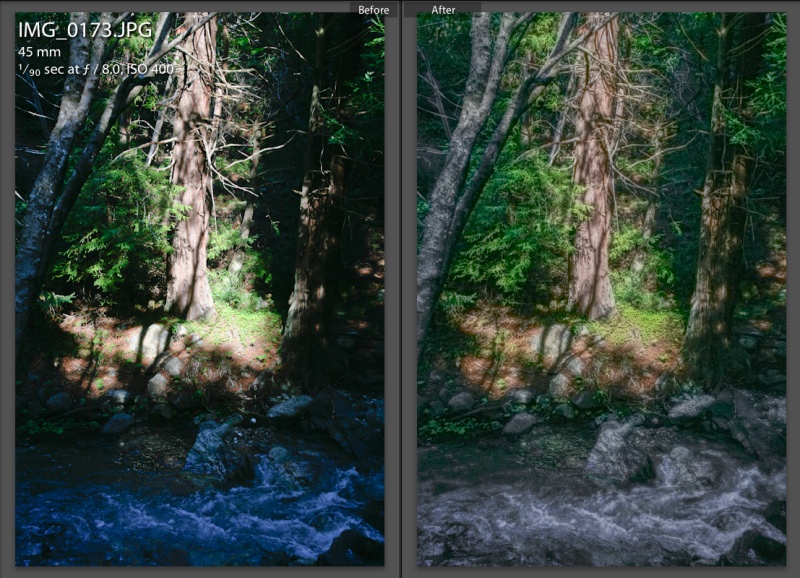A non-trivial improvement.
When Lightroom 4 first came out I pooh-poohed the improvements. The book module, restricted to Blurb as a printing house, was no big deal and the code bloat was awful, with the app some nine times the size of Lightroom 3.
The GPS mapping feature is OK but needs more work (trip route indication based on file times would be a start) and a global change to the new 2012 process for one’s picture catalog would be insanity. Some of the changes are significant and you risk messing up hundreds of hours of processing work. However, credit where’s it’s due. For the right image LR4’s ability to recover highlight detail where there was none is extraordinary, matched by its enhanced capabilities in the shadows.

Limekiln, 5D, 24-105. LR3 left, LR4 right.
For many users the enhanced capabilities of LR4 obsolete HDR with its clunky processing cycle and default ‘awful orange’ look. HDR is increasingly the province of the Kinkade Set which never saw a piece of kitsch it did not like. For those new to Kinkade he is the drunken letch – now mercifully deceased – who gave the world crap for the wall in abundance. You can search his name because I’m damned if I’m printing his garbage here. The man makes HDR look good.
But Adobe didn’t leave 4.0 alone. The Bokeh Cabal was going on about how some lenses were rendering out of focus detail with purple color fringing, even though LR fixed the in focus bits well. Adobe calls this ‘lateral chromatic aberration’. So they added an enhancement in LR 4.1 to fix this. I paged back through my catalog to some images snapped on the Panny LX-1 which, though it has a decent Leica lens, opts for purple fringing at every opportunity. Sure enough, Adobe was telling the truth. Their enhanced chromatic aberration correction really works.
For photography LR4 is the single biggest improvement I have seen in ages, increasingly obsoleting add-ons and Photoshop itself, the latter restricted to the occasional round trip to fix leaning verticals or to add blur or to erase Cousin Vanya, and so on. And while Adobe’s corner office seems to have frequent difficulty telling its ass from its elbow, there is no denying that their crackerjack software engineers are the bees’ knees. Too bad Apple has abandoned its original constituency of creative users, as ADBE would be chump change for AAPL and a great fit.
As for processor efficiency, LR4 barely moves the needle on CPU temperature when processing; Aperture, in its defense, does permit you to brew your tea on the keyboard under like conditions, at half the price of LR. Neat feature, that.
Lightroom has had perspective correction (leaning verticals) since Lightroom 3, with a much better user interface than Photoshop to boot. There is really no reason to use PS, which is a good thing, since to paraphrase Borges, each successive version of Photoshop makes you long for the previous one (due to accreted bloat and bugs).
Horses for courses. There are lots of reasons to use PS, especially CS5 (Content Aware Fill) or CS6 (moving elements). It depends on your needs. But a doctrinaire sweeping statement like yours that there “…. is really no reason to use PS ….” in not helpful. Next time you want to accurately outline an element – right down to the finest wisps of hair – in a picture to change it, try doing that without Photoshop. Further the perspective correction in LR is very crude compared to what’s available in PS, as I have illustrated here before. Links download instructional videos. – Ed.
So what does LR4 do to the settings on a LR3-processed RAW? Does it translate them faithfully?
Once you ‘convert’ to LR4 both versions are retained – you can revert to LR3. The conversions are mostly the same but in high contrast snaps I find the default LR4 conversion has a better dynamic range. However, once you start using the sliders (renamed in LR4) the ability to recover highlights and enhance shadows is significantly greater. The underlying RAW file remains unchanged, of course. – Ed.
Also, have you noticed whether LR4 is better in handling high-ISO noise?
No. I found the big jump in noise handling was in going from LR2 to LR3 which brought far better retention of detailed when trying to eliminate noise. ‘Smearing’ was largely gone. LR4 seems unchanged in that respect from LR3, judging from G1 and G3 originals at ISO 1600 – Ed.
So I’ve upgraded to LR4 from LR3.
Sound move – Ed.
After using LR4 on about 60 photographs, my observations:
1. Overall LR4 Develop is improved over LR3.
2. I find I have to dial up the clarity by a few compared to LR3 to get the same look.
3. I sometimes wish the lens corrections was the second item on the workflow after white balance. This is because lens corrections fixes vignetting which makes the photograph brighter and I have to visit the other controls again.